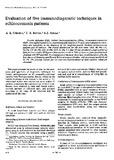| dc.contributor.author | AK, Chemtai | |
| dc.contributor.author | TR, Bowry | |
| dc.contributor.author | Z, Ahmad | |
| dc.date.accessioned | 2013-06-10T11:51:55Z | |
| dc.date.available | 2013-06-10T11:51:55Z | |
| dc.date.issued | 1981 | |
| dc.identifier.citation | Bull World Health Organ. 1981; 59(5): 767–772 | en |
| dc.identifier.uri | http://www.ncbi.nlm.nih.gov/pubmed/6976237 | |
| dc.identifier.uri | http://erepository.uonbi.ac.ke:8080/xmlui/handle/123456789/30739 | |
| dc.identifier.uri | http://www.ncbi.nlm.nih.gov/pmc/articles/PMC2396102/ | |
| dc.description.abstract | Double diffusion (DD), indirect haemagglutination (IHA), immunoelectrophoresis (IEP), latex agglutination (LA), and complement fixation (CF) tests were evaluated for sensitivity and specificity in the diagnosis of 141 surgically-proven Turkana echinococcosis patients and 10 controls. The overall sensitivities for the tests were: IHA, 86.7%; LA, 53.3%; CF, 63.3%; DD, 55.0%; IEP, 55.0%. LA and CF tests produced a high number of false positive results; IHA gave a false positive result in 10% of cases; no false positives were obtained with IEP and DD. A combination of the latter three tests would therefore offer the best chance of detecting specific anti-Echinococcus antibodies, with an average sensitivity of 62.7%. The possible reasons for the relatively high incidence of false negative values are discussed. | en |
| dc.description.uri | http://www.ncbi.nlm.nih.gov/pmc/articles/PMC2396102/ | |
| dc.language.iso | en | en |
| dc.publisher | University of Nairobi | en |
| dc.title | Evaluation of five immunodiagnostic techniques in echinococcosis patients | en |
| dc.type | Article | en |
| local.publisher | Department of Infectious Diseases | en |


